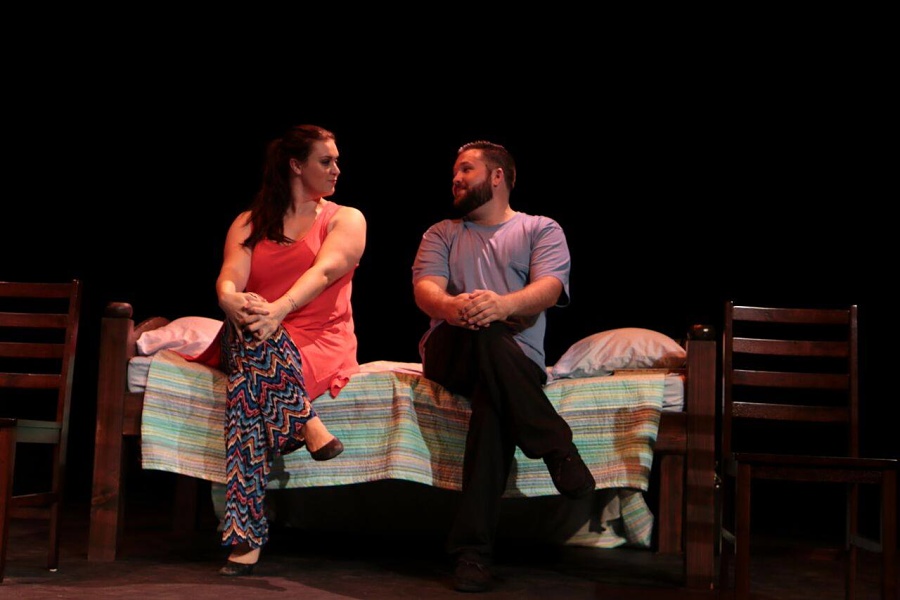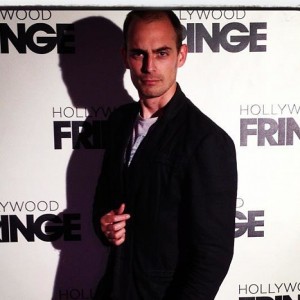This is the second of a two-part series on the Hollywood Fringe Festival; part 1 is here.
LOS ANGELES: James Chang owns the P&J Liquor-Deli in Hollywood, in the same historic building as the 10 performance spaces collectively called the Complex. One of them, the Ruby Theatre, is hosting 15 of the 300 acts that make up this year’s sixth annual Hollywood Fringe Festival (HFF), running through June 28. The Complex and 30 other Hollywood venues centered around Santa Monica Blvd. surely benefit from the windfall that comes at this time every year. Don’t they? Chang remains unimpressed.
“In June,” the liquor store proprietor tells me, “business picks up a little bit, maybe. It’s never an easy business.”
Ask an actor and you’ll get a similar story.
“If I sell out the entire run, I’ll only lose 1,000 bucks,” says Chris Piehler, whose autobiographical monologue about pony shows, Reserve Champion, is playing in one of the spaces at Theatre Asylum, a block west of the Complex across Cahuenga Boulevard. “I’ve got about a $2,500 budget altogether. I’m paying $500 to rent the space for a preview and four performances, plus $150 insurance through Asylum. Then I had to rent a rehearsal space, too. The Fringe entry fee was $250. My set cost about $45. There’s $20 an hour for a stage manager and board op. Lots of little stuff.”
Elena Vannoni, who’s directing her adaptation of the Chekhov one-act The Marriage Proposal at the Hudson Guild Theatre, a half-mile northeast of Theatre Asylum, agrees: “It’s very easy to spend a lot of money. Opening week is a nightmare of details. The props, the costumes, postcards, tech, everything comes together. If I worry about the money, too, I’ll lose my mind. That’s for the producer.”
Vannoni is happy to have not only someone else looking after the bills, but also an assistant director, as well as individual department heads for costume, set, lights, music, and graphic design.
Of his own operation, Piehler says, “The whole thing has to fit into my Mini Cooper.”
But that’s the Fringe: One size fits all, and even the smallest outfit may dream of making its passion project work for its own needs.

“The Fringe has been very helpful,” Piehler says. “There was a big meeting at the beginning of the year where they gave good advice, like, ‘Choose the smallest space you can imagine.’” Piehler picked a 24-seat venue that was hosting a high volume of shows, so that he could take advantage of overlap and marketing visibility. “Really, logistics have not been a problem at all,” he says. “The only issue was my use of space vs. other users. You get twice your running time in terms of tech, which is not much. Load-in and load-out times are 15 minutes, and knowing that up front helps you arrange your system. There’s no storage at the space, so within that 15 minutes you need to be able to get in, set up your stage and load the board, and on the back end, you have to be able to clear out onto the sidewalk so the next show can load.”
As festival founder and director Ben Hill likes to say, the first rule of Fringe is, “Don’t be a jerk.” Professionalism is politeness to one’s fellow artists; it’s less a virtue than a mandate. Lighting and sound designer Matthew Richter intimately understands the concept, having been the HFF technical director for years two, three, and four.
“I board-op’ed the single worst performance ever to occur in the history of humanity, and I say that having worked on several shows that could not be qualified as good,” Richter says. “Any time a performer requests a tarp out of the blue it’s a little worrisome, and coming from out of town, this gal didn’t have a stage manager. We gave her an intern, but when I saw what the show looked like I took over myself, because I didn’t want the intern to be traumatized out of the industry. A woman dumping fluorescent paint all over her naked self, accompanied by Prince’s ‘Purple Rain,’ might do that. Organized she was not: The first night she showed up with a laptop and a CD and a DVD; the second with a different laptop and her phone. She never once in five performances showed up with the same set of equipment.”
One might expect a man who has worked on 60 shows in a single month to have little remaining patience. Instead, Richter says, “In that situation you do what you’d normally do, which is your best. You’ve got a performer here without any connections to the preexisting community, zero resources to draw on, you’re the only thing making their show happen. They deserve the best you can give them. Her audiences were…extremely intimate. I tried to get people to come see her, because the whole mess is one of the beauties of fringe. It reminds you why you continue in this difficult task: You can see a show that makes you want to rip out your eyes and shove them in your ears, but the whole audience is having this experience, so it’s shared.”

The flexibility needed at HFF is familiar to Janet Miller, a veteran director and producer who’s participated three times since 2010’s first.
“The first time, with a two-and-a-half-hour musical, we bought out our theatre,” so as not to bother with a load-in, load-out situation every night. “Fringe said, ‘That’s not what we do—but we can do that.’” This year she’s downsized “to play the Fringe game.” Her 70-minute production of Stephen Sondheim’s Marry Me a Little at the Lillian Theatre (the largest venue in the Asylum building) features two actors and a musical director, though her background in more legit theatre still nags at her sensibilities. “People ask why I don’t have more stuff onstage, and I say, ‘I wish! But I’ve got 15 minutes to set up.’
“Fringe is good for the novice and the professional alike,” she muses. “The kids, bless ’em, can throw it up for three to five performances and make a lot of mistakes and try stuff out. For those of us who’ve been around the block a little, if there’s something that speaks to us and we want to do it, Fringe is a venue with a cost-benefit even if you do a 13-performance run and you buy out the space.”
That cost-benefit analysis is one that many theatre practitioners consider when deciding not only what to do at a fringe festival, but which fringe at which to do it. There are accessibility and entrance issues to weigh, problems of expenditure and return to think about.
David LeBarron has participated in three HFFs and one New York International Fringe Festival (FringeNYC), and this year chose to stage his role-playing game musical Nerd Anarchy at the hipper-than-thou Vine Street bar Three Clubs. His report from the various fronts: “You keep 100 percent of your box office in Hollywood, but we made more money in New York. They have really supportive theatre audiences over there. In Hollywood you have to build your own audience.
“I like that FringeNYC is curated,” he continues. “I think that sometimes Hollywood Fringe supports the lack of experience and the naivete of the people involved more than the audience will. But if you’re still in the process of developing a show, don’t take it to New York; after you’re accepted, you’ve got two months to do all your press and marketing materials, and you can’t be working on the show and selling it at the same time. But actually FringeNYC’s very helpful with marketing, and at HFF you’re on your own.”
This year Brendan Hunt has his fingers in several Hollywood Fringe shows: He’s directing King of Kong, which won FringeNYC’s 2014 Best Overall Musical award; he’s written Absolutely Filthy, a returning winner of several awards from last year’s HFF; and he’s performing in several, including as Edgar Allan Poe in The Poe Show. He’s been around the fringe circuit, in other words, and in his estimation, HFF is “the most positive fringe experience I’ve had. I like what they’re building: a real fringe, a legitimate cultural experience.
“It’s extremely hard to do well at Edinburgh Festival Fringe,” says Hunt. “It’s so big. And we did very well in New York, but I don’t know that we’d go again. At Edinburgh, if there’s a problem, someone steps up. At Hollywood, you’ve got a site manager. At FringeNYC no one seemed to care what happened. At both New York and Edinburgh it’s easy to feel isolated from the organizers. They are more prestigious destinations, but the tradeoff is that if your show is good at HFF, you’re more likely to be found.
“Also,” he raves,“the HFF app is fantastic. It’s so easy to check reviews, buy tickets, and see other shows. It struck me as crazy that New York didn’t have such a thing when we were there. But quality-wise it’s pretty much the same: some crazy, left-field comedy; some young people finding their feet; and the occasional shit show unnecessarily devoted to some college project they’ve never let go of. But there’s lots of talent in L.A. and not much to do in the summer, and a fringe festival is one of the most fun things a performer can do.”
Australian illusionist Simon Coronel would seem to agree. This year, in which he brings his “deconstructed magic” show Glitches in Reality to the Elephant Space, marks his fourth HFF. He’s also performed at Edinburgh and at the Adelaide and Melbourne Fringe Festivals, twice at the Melbourne Comedy Festival, and three times at the Fringe World festival at Perth. The differences can be stark.

“You’ve got 8 minutes’ turnaround at Edinburgh vs. 15 at Hollywood,” Coronel says. “That’s a bigger change than it sounds. And HFF has an erratic time schedule: one of your shows in the morning, one in the middle of the night. Other fringes give you more or less a solid block. Perhaps it’s a reflection of a more erratic lifestyle in L.A.?
“As far as venue, Perth is the easiest fringe to get a space: They give you one. In Perth there are no venue charges, no fees, and you keep 70 percent of the door. But in Hollywood you have to find your own venue, and so it’s very hard to make your money back here. I use Hollywood to get high-end feedback, mostly; in a town with this many entertainers, you get a very high class of performer and audience. Lots of people I know come to my show and they really know their stuff. It’s a better crucible than most.”
If Coronel’s ambivalent relationship to HFF is common to many repeat practitioners, so is his high praise for Perth’s Fringe World. Acts who have played there, including the L.A.-based Shakespearean drinking-game show Shotspeare, all want to go again. Shotspeare director Matthew Morgan says, “They basically shut down Perth so you can show them a good time.”
According to Coronel, “Perth is my favorite in every way. Their financials are terrific. The government sponsors the festival, which subsidizes practitioners. It’s easy to get bums in seats in a city that’s cash-rich and entertainment-starved. Even with no publicist you’ll get crowds. Hollywood is on the other end: cash-poor, with so much entertainment that some people will stay home to avoid it.”
The issue of government support of the arts is a touchy one in America, as Ben Hill knows very well.
“I’d go to Perth,” he says. “In the United States, we have some things stacked against us. If a liberal Democrat from Chicago becomes president and we still get very little federal support for the arts, we can’t be that optimistic. It’s why HFF said, ‘Let’s make a model that works with skeletal staff, that can operate with low overhead.’”
So the HFF has to more or less make its own way. In its first two years, it received no public funds. Six years in, its annual $500,000 budget includes $13,000 from the City of Los Angeles, about the same from L.A. County, and $2,500 from City Council District 13. The other 95 percent of this year’s operations are funded by a private grant from the California Community Foundation ($50,000 over two years) and by Fringe-related revenues: registration fees, ads on the Fringe website, merchandise, fundraisers, crowdfunding campaigns, ticket service fees, and the bar at Fringe Central. HFF events sold 46,000 tickets last year.
By comparison, Fringe World in Perth—as isolated a metropolis as exists on earth—in 2014 recorded attendance at ticketed events in excess of 150,000, and box-office sales upwards of 2.4 million American dollars. Fringe World is able to return more than two-thirds of those sales to participating artists, since its million-dollar operating budget is almost entirely state-supplied, funded partly by a state lotto, Lotterywest.
Still, according to Godfather of the American Fringe Ezra Buzzington, “Art will out. Fringe is the future of American theatre. There’s zero stopping it. Just as the more Equity sits on top of 99-seat theatre, the more 99 seat theatre will come back,” he says, referencing Actors’ Equity Association’s controversial kibosh of L.A.’s waiver code, “the longer Fringe lasts, the more momentum it will gather. It’s just logical that this will happen.”
Hill is equally adamant about the value of intimate, inexpensive productions. He sees the furiously inclusive, uncurated, anything-goes fringe concept as a tool to help build community.
“Do whatever you want,” he says, “but create an environment where people want to be. People want to do art with people they like, rather than their actor day job of doing another commercial with a stranger. It’s why I do this year-round. People want to be around cool people.”
Jason Rohrer is a theatre and film critic based in Los Angeles.


